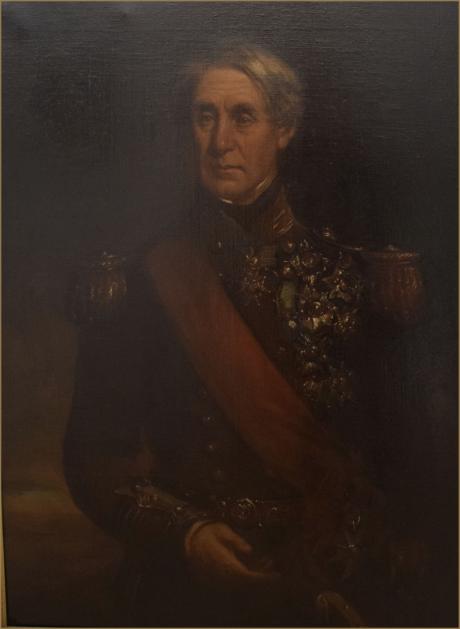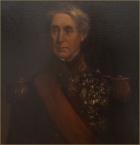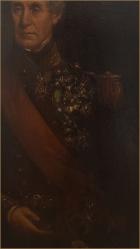Newbold Pacey Hall, Warwickshire
Admiral Edmund Lyons, 1st Baron Lyons, GCB, GCMG, KCH (21 November 1790 – 23 November 1858) was an eminent British Admiral of the Royal Navy, and an eminent British diplomat, who was responsible for encouraging the Crimean War, during which he was Commander-in-Chief of the Mediterranean Fleet, and for the securing the subsequent allied victory in the conflict, through his efforts at the Siege of Sevastopol (1854–1855) with both the Navy and the British Army.
As a consequence of his linguistic ability and favour with foreign aristocrats, Lyons was appointed to various diplomatic posts, including important ambassadorial positions in Sweden, Switzerland, and to the court of King King Otto of Greece. Lyons's temerity, ambition, and charisma, for which his white-blonde hair and pale complexion became a byword, made him popular with the High Commands of the Royal Navy and British Army and with the British aristocracy, with whom he maintained secret private correspondences to which his naval immediate superiors were not privy. His friendship with Fitzroy Somerset, 1st Baron Raglan facilitated the integration of deployments that ensured allied victory in the Crimean War.
Edmund Lyons was the father of the diplomat Richard Lyons, 1st Viscount Lyons, the British Ambassador to the USA who solved the Trent Affair, and later British Ambassador to France. Edmund's eldest brother was Vice-Admiral John Lyons (1787 - 1872), who was on board HMS Victory at the Battle of Trafalgar and who served as British Ambassador in Egypt, and his nephews included Sir Algernon McLennan Lyons, Admiral of the Fleet (1833 – 1908).
Edmund Lyons was born at Whitehayes House, Burton, near Christchurch, on 29 November 1790. He was the fourth son of Captain John Lyons, an owner of extensive sugar plantations in Antigua, whose British residence was at St. Austen's, Lymington, Hampshire, and Catherine (née Walrond), daughter of Maine Swete Walrond, 5th Marquis de Vallado. His brothers included Vice-Admiral John Lyons (1787 - 1872), who was on board HMS Victory at the Battle of Trafalgar and who served as British Ambassador in Egypt; Maine Walrond Lyons, (1798–1827), a lieutenant in the Royal Navy who was killed at Battle of Navarino; and Humphrey Lyons (1802–1873), a lieutenant-general in the Indian (Bombay) Army.
His nephews included Sir Algernon McLennan Lyons, Admiral of the Fleet (1833–1908), who served under him during the Crimean War, and Richard Lyons Pearson, Assistant Commissioner of the Metropolitan Police. His godparents were Sir Richard Hussey Bickerton and Lady Bickerton.
Lyons first went to sea on board HMS Terrible in 1798, when he was eight years old. He then returned to England to attend Hyde Abbey School near Winchester, which he attended until 1803, when he joined the Royal Navy and the crew of the frigate HMS Active, with which he remained for four years. He served at the passage of the Dardanelles, under Sir John Duckworth, in February 1807. He was posted to the West Indies later in 1807 and commissioned as a lieutenant in 1809, as which he participated in the capture of Banda Neira, for which he was mentioned for gallantryand promoted.
He then served as a flag-lieutenant, to Rear-Admiral Drury, aboard HMS Minden (74 guns). In 1810, he served in the 18-gun sloop HMS Barracouta notably at the capture, from the Dutch, on 9 August 1810, of Banda Neira in the Moluccas during the Invasion of the Spice Islands: Lyons was involved in the assault on Fort Belgica.
In 1811, a planned attack by the whole fleet on the heavily defended port of Fort Marrack, in the Sunda Strait, Batavia, was ordered to be postponed after the navy received intelligence that extensive Dutch reinforcements had arrived. Lyons, acting on his own initiative, decided to attack the fort anyway and destroyed it, with its 180-strong garrison and 54 guns, with only 34 men.
On 25 July, Lyons was dispatched to land Dutch prisoners on the island. On his return journey, on 30 July, acting on his own initiative, he decided to launch a surprise midnight attack on the Dutch fort with the 34 men who accompanied him. Lyons stormed the Dutch battery, captured it, dispersed the Dutch garrison of 180 men and two boat crewsand gunned down the Dutch reinforcements as they arrived, before dismantling the fort, destroying its 54 guns] with dynamite (so that they could not be used on the British Fleet), and returning to his ship.
This action made Lyons famous within the Royal Navy and was praised as ‘the most outstanding example of individual bravery in the wars which followed the French Revolution’ for decades after it occurred. Lyons’s Commander-in-Chief, Commodore Broughton, acknowledged Lyons’s 'gallantry and zeal' but criticised him because 'the attack was made contrary to orders'. For this action, however, Lyons was mentioned in dispatches and, despite the fact that he had acted without orders, proposed for early promotion to the rank of Commander, which he received on 21 March 1812.
After his attack on Marrack, Lyons’s health deteriorated and he returned to Britain. In 1814, he was promoted to captain and commanded the sloop HMS Rinaldo in the fleet that escorted the French King Louis XVIII and other allied sovereigns from England to France. On 18 July 1814, at Southwick, Hampshire, he married Augusta Louisa (1792–1852), daughter of Captain Josias Rogers of the navy. He was unemployed until 1828, whilst he and his wife had two sons and two daughters:
- Anne Theresa Bickerton Lyons (1815–1894), who married Philip Hartmann Veit von Würtzburg, Baron von Würtzburg, in Bavaria, in 1839.
- Richard Lyons, 1st Viscount Lyons (1817–1887). Eminent diplomat who served during the American Civil War and solved the Trent affair and founded the Lyons School of Diplomacy. He was a favourite of Queen Victoria who stated that she would allow him to represent her ‘at any court in the world’. Richard was granted the higher noble titles of Viscount (1881) and Earl (1887), but he died, unmarried and without issue, before he had formally received the latter.
- Edmund Moubray Lyons (1819–1855). Captain in the Royal Navy. He was killed in the Crimean War and died without issue.
- Augusta Mary Minna Catherine Lyons (1821–1886), who married, in, 1839, Henry Granville Fitzalan-Howard, 14th Duke of Norfolk. Her grandson was Philip Kerr, 11th Marquess of Lothian.
Lyons's flagship from 1828 to 1831, HMS Blonde. Lieutenant Maine Walrond Lyons, one of Edmund Lyons's younger brothers, was killed at the Battle of Navarino in 1827. The Duke of Clarence, the heir presumptive to the British throne, heard of the loss and appointed Edmund, in 1828, to command the 46-gun frigate HMS Blonde during the final stages of the Greek War of Independence. When Lyons arrived in Malta on 20 May 1828, Sir Richard Hussey Bickerton and Admiral Sausages described him, in letters to the Fleet Commander, as 'a man of intelligence and great ability' who was 'blessed' with military competence. Lyons and his wife rented the most expensive house in Valletta, where they homeschooled their four children in grammar, language style, and Enlightenment philosophy.
On HMS Blonde, Lyons was involved in the capture of Kastro Morea in the Peloponnese, for which he was knighted in both France and Greece. The following year, Lyons took the Blonde around the Black Sea to become the first British warship to visit Sevastopol, the Caucasus, and Odessa: 25 years later, Lyons was the only senior officer involved in the Crimean War to have prior knowledge of the Black Sea.
In 1831 Lyons was appointed to command of the frigate HMS Madagascar: he brought the Madagascar home to England but sailed again in her for the Mediterranean in February 1832.
In August 1832, Lyons transported the newly chosen King Otto of Greece, and the Bavarian Regency, from Brindisi to Nauplia, and then, in 1833, from Trieste to Athens.
As a consequence of his rapport with King Otto of Greece, Lyons left the navy in January 1835, received another knighthood, in the Royal Guelphic Order, and was appointed by Lord Palmerston as a diplomat as the British plenipotentiary at Athens, as which he remained for almost fifteen years.
On 29 July 1840 he was created baronet, and in July 1844 he was made a Knight Grand Cross in the Civil Division of the Order of the Bath.
In 1849 he was appointed Minister Plenipotentiary to the Confederated States of the Swiss Cantonsand, although he was not in present service with the navy, he was promoted to rear-admiral in the navy on 14 January 1850. In 1851 he was appointed minister at Stockholm, where his wife died.
In November 1853, with the advocacy of Sir James Graham, Lyons returned to active service in the Royal Navy and was appointed second in command of the British Mediterranean Fleet. At the same time, he was granted a pension of £900 per annum for his years of diplomatic service. Lyons left England for the Dardanelles, as Rear-Admiral of the White, on board the steam frigate HMS Terrible on 5 November 1853. He then took command of his flagship, the brand new screw steam ship-of-the-line HMS Agamemnon (1852) (91 guns).
Lyons was preferred as a Mediterranean commander as a consequence of his linguistic ability, his experience as a diplomat, and his charismatic leadership, the latter of which was conspicuously lacked by the Commander-in-Chief, Vice-Admiral Sir James Dundas. Lyons maintained a secret private correspondence with the First Lord of the Admiralty, Sir James Graham, whose plans for an amphibious assault on Sevastopol Lyons advocated at the Allied Counsels of War between July and August 1854, in defiance of the policy his immediate superior, Vice-Admiral Dundas.
Lyons maintained this private correspondence, with the head of the Royal Navy, in addition to direct private correspondences with various Cabinet ministers, without the permission of his immediate superiors. Lyons also undertook to communicate with the British public directly, again in defiance of his Vice-Admiral, by publishing memos in The Times newspaper, without permission, through reporters such as John Delane, Austen Henry Layard, and William Howard Russell: in these he criticised the policies of his admiral, Dundas.
Dundas disliked Lyons’s wilful independence and Lyons’s refusal to acknowledge the authority of any but the highest officers. However, Dundas’s superiors, the heads of the navy, to whom alone Lyons considered himself answerable, preferred Lyons, whom they considered to be the more competent and the more charismatic, and encouraged his independence, engaging in an extensive private correspondence with him and issuing multiple secret orders to him. Lyons was privately entrusted with plans, such as those for the assault on Sevastopol, by the First Lord of the Admiralty, Sir James Graham, to which officers between Graham and Lyons in rank, such as Dundas, were not privy. Both the entire English Fleet and the entire French Fleet zealously commended Lyons's 'skill and boldness' during the Crimean War.
Lyons’s white-blonde hair became identified with his singular maverick temerity. Lyons’s hair was similar to the hair of Nelson, to whom Lyons was frequently compared, and whom Lyons idolized. However, Lyons did not possess the strategic intelligence of Nelson and typically attained his victories, such as the destruction of Fort Marrack (see above) and the attack on Sevastopol (see below), by extraordinary spontaneous temerity and aggression, rather than by meticulous formal planning. Lyons disliked paperwork: when Admiral Dundas ordered him to organize transports for the invasion of the Crimea, Lyons immediately employed a subordinate, his flag captain William Mends, to do it for him.
Furthermore, Lyons’s charisma made him a favourite of the Army General Lord Raglan, with whom he maintained another private correspondence. The friendship between Lyons and Raglan was productive of an inter-service rapport during the Crimean War and Lyons served as an intermediary between the Navy and the Army. When Lyons captured Balaklava, he advised Raglan to adopt it as the base for the British Army: Raglan did so. However, this was a poor decision because it compelled the army to suffer the Crimean winter.
Although he was a Naval Commander, Lyons led a force during the diversionary attack on Sevastopol on 17 October 1854. Idiosyncratically, Lyons ignored Admiral Dundas’s orders to remain disengaged and proceeded to attack on his own initiative: on this occasion, however, Lyons’s attack was unsuccessful and the ships were damaged and heavy casualties sustained. However, although the attack failed, Lyons was praised for his bravery by the High Command. Lyons conceded that he was responsible for the failure, but the High Command blamed Dundas for the failure, dismissed Dundas, and, in January 1855, made Lyons Commander-in-Chief.
Lyons continued to work productively with Raglan to improve supply arrangements in the Bosphorus and at Balaklava. Lyons secured another diplomatic triumph when he secured, in May 1855, French consent to capture of Kerch and occupation of the Sea of Azov: this operation destroyed the logistic support of the Russian army in the Crimea and enabled the allied victory.
In June 1855, Lyons lost both his own son, Captain Edmund Moubray Lyons, of the Royal Navy, (1819–1855), who had been severely wounded in a night attack on Sevastopol, and his close friend and colleague Lord Raglan. After the fall of Sevastopol, Sir Edmund Lyons led a successful expedition to capture Kinburn on 17 October 1855, which opened up the Bug and Dnieper rivers for allied operations. This was the first military action to involve the use of armoured warships. In July 1855, Lyons, who had already received the honour of Knight Grand Cross of the Civil Division of the Order of the Bath, received the honour of Knight Grand Cross of the Military Division of the same order. He is one of few persons to have attained the rank of Knight Grand Cross in both divisions of the Order.
In January 1856, Lyons attended the allied Council of War at Paris and advocated increased aggression. After the Treaty of Paris, he relinquished his post of Commander in Chief of the Royal Navy in the Mediterranean. When he returned to London, a Grand Banquet was hosted for him at the Mansion House, London and he was awarded the Freedom of the City of London on 24 May 1856. Lyons’s contribution to the Crimean War was imperative to the allied success. He was largely responsible, at the allied council of war, for the decision to attempt the operation. He transported the British Army to the Crimea and subsequently ensured its supplies and supported it militarily on land, where he led assaults, including the Kerch operation. His friendship with Lord Raglan enabled the coordination of the British Army and Navy, the officers of both of which were endeared to his charisma.
Edmund Lyons's eldest son, Richard Lyons, 1st Viscount Lyons, the favourite diplomat of Queen Victoria. Already a baronet, he was created a Baron, Baron Lyons of Christchurch, and raised to the peerage on 23 June 1856. He entered the House of Lords between Admiral George Byron, 7th Baron Byron and Thomas Foley, 4th Baron Foley. He was promoted to Vice-Admiral on 19 March 1857 and held the temporary rank of Admiral from December 1857 until his death. He returned to Britain in 1858, and escorted Queen Victoria to Cherbourg in August 1858.
Lyons died at Arundel Castle, the seat of his son-in-law, Henry Granville Fitzalan-Howard, 14th Duke of Norfolk, on 23 November 1858. He is interred in the vault beneath the Fitzalan Chapel at Arundel Castle.There is a life size statue of him, by Matthew Noble, in St Paul’s Cathedral, which remains in place.The Edmund River and Lyons River in Australia are named after him.
Lyons's ‘bravery, spirit, and commitment’ earned him the loyalty of the subordinate officers and rank-and-file whom he commanded, with whom he shared his glories: he has been described as ‘as lavish with his praise of others as he was anxious to be praised by his superiors [the High Command]. However Lyons was described by the Foreign Secretary, Lord Clarendon, whom he had disobeyed, as ‘irritable and one of the vainest men I ever knew’.
Lyons received the following honours:
- 1828 – Knight of the Order of St Louis (France)
- 1833 – Knight Grand Cross of the Order of the Redeemer (Greece)
- 1835 – Knight Commander of the Royal Guelphic Order (House of Guelph)
- 1840 – Baronet (United Kingdom)
- 1844 – Knight Grand Cross of the Civil Division of the Order of the Bath (United Kingdom)
- 1855 – Knight Grand Cross of the Military Division of the Order of the Bath (United Kingdom)
- Knight Grand Cross of the Order of St Michael and St George (United Kingdom)
- 1855 – Knight Grand Cross of the Order of the Medjidie, 1st Class (Ottoman Empire)
- 1855/6 - Knight Grand Cross of the Legion of Honour (France)
- 1856 - Freedom of the City of London
- 1856 – Grand Cross of the Military Order of Savoy (Italy)
- 1856 – Raised to the Peerage of United Kingdom as Baron Lyons, of Christchurch, Hampshire, (United Kingdom).
George Frederick Clarke was born at Carrick-on-Suir on the 13th April, 1823, son of Usher Clarke, brewer, and Sarah R. Corbett. He commenced his art career in Dublin, and from 1845 to 1848 exhibited Portraits in the Royal Hibernian Academy. Anxious to advance himself he left Ireland and settled in London, where he exhibited in the Royal Academy and Society of Britsih Artists between 1868 and 1872. A Painter of considerable talent he enjoyed for a considerable time a pair practice; but during the last 20 years of his life he did more copying than origina work , and was much employed by Sir Francis Grant in making copies of his pictures for engravers. Eventually through failure of his sight , he had to abandon his work.He was throughout his life a keen field sportsman, enjying fishing and shooting and all outdoor sports . He died on the 8th March 1906.



